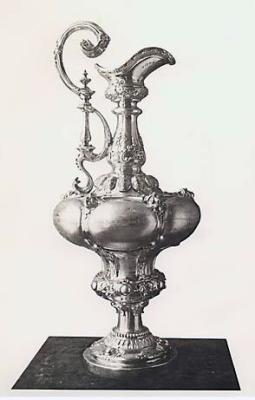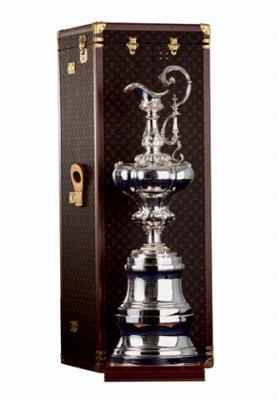155 Years Ago Today Aug 22, 08:10
 It all began on 22 August 1851. The schooner yacht America defeated Aurora and 13 others of the Royal Yacht Squadron fleet in a race around the Isle of Wight off the south coast of England.
It all began on 22 August 1851. The schooner yacht America defeated Aurora and 13 others of the Royal Yacht Squadron fleet in a race around the Isle of Wight off the south coast of England. For their efforts the syndicate of New York Yacht Club members was awarded a bottomless pitcher ("ewer" to be more precise), 27 inches tall and crafted of 134 ounces of silver plate in 1848 by the crown jewellers, Garrard of London. The trophy was bought "off-the-shelf" -- it was not unique nor purchased for the occasion -- by Lord Anglesey, who donated it to the Royal Yacht Squadron.
To great acclaim, the syndicate returned with the Cup (and the tidy sum of $25,000 for which they sold America before leaving England) to pre-civil war USA. In 1852, 44 years before the French aristocrat Pierre, baron de Coubertin staged the first modern Olympic Games (1896), America syndicate members drafted a "Deed of Gift" donating the trophy to the New York Yacht Club "upon the conditions that it shall be preserved as a perpetual Challenge Cup for friendly competition between foreign countries" -- a radical idea in those days.
 Our longtime friend Bob Fisher (GBR), widely regarded as the dean of the Cup journalists (he wouldn't disagree), is writing an exhaustive book on the Cup's history. Bob said in a recent email:
Our longtime friend Bob Fisher (GBR), widely regarded as the dean of the Cup journalists (he wouldn't disagree), is writing an exhaustive book on the Cup's history. Bob said in a recent email:The original Deed of Gift of the America's Cup was handwritten by George Schuyler to the NYYC on May 15th 1852. The date was subsequently altered (in the same hand) to July 8th 1857, the date it was accepted by the club. The original is safely kept under temperature and humidity controlled conditions in the "Rare Books and Archives Room" in the Library of the New York Yacht Club at 37 West 44th Street, Manhattan.
Others have reported that during mid-1850s the trophy languished in a syndicate member's closet; at one point they apparently considered melting it down to make medallions for the syndicate.
Finally, in 1857 the Deed was done. However, it was not until 1870 (after the American civil war) that the first challenge came from the Royal Thames YC (GBR) and James Ashbury with his yacht Cambria. By then the trophy was known popularly as "The America's Cup" -- notwithstanding the trophy bears the inscription "Hundred Guinea Cup."
 John Rousmaniere (USA), yachting writer/historian and an esteemed NYYC member, shed further light on all this in a recent email:
John Rousmaniere (USA), yachting writer/historian and an esteemed NYYC member, shed further light on all this in a recent email: The cup was originally called the Hundred Pound Cup because that's what it cost, but was sometimes called the Hundred Guinea Cup.
In the Royal Yacht Squadron the cup was nothing special, just an ordinary trophy on the shelf that had a familiar design and had cost 100 pounds. So it was referred to as "the £100 Cup" [witness the RYS poster from 1851, above]. As another indication of the trophy's ordinary status, since a pound at that time was also called a sovereign, people also casually referred to it as "the Hundred Sovereign Cup."
Whoever set out to inscribe the original name on the trophy, probably the Americans, got their guineas mixed up with their pounds -- neither the first nor the last to do so -- which is why the name inscribed on it is "Hundred Guinea Cup."
The original name was a functional one, not an honorific like "Queen's Cup," which was how it was first called after coming to America. NYYC founding Commodore and syndicate member John Cox Stevens was the first but not the last Cup notable with a touch of grandiosity, and he liked to tell people that Queen Victoria had personally handed the trophy to him. When the American press and the NYYC eventually settled on "the America Cup" and, later, "the America's Cup," they returned to a functional name.
Needless to say, 22 August 1851 turned out to be an important day for the sport of yacht racing, indeed for international sport. No doubt the Cup's historical significance is a large part of why today, 155 years later, so many us here in Valencia, and around the world, are pursuing it with such passion.

The "£100 Cup" on which is inscribed "Hundred Guinea Cup," for a time referred to as the "Queen's Cup," that came to be known, popularly in the press, as the "America Cup" and, finally, the "America's Cup."

The America's Cup today, with the two base sections added in 1958 and 2003 for more inscription space, in front of its modern-day Louis Vuitton case. The cup is engraved with the names of all the yachts that raced America in 1851, with the exception (strangely) of the runner-up Aurora, and with the name of every yacht since 1851 that has raced in an America's Cup Match (finals).
P.S. We posted a few other tidbits on this subject this afternoon over on the Challenger Commission Blog, including a photo of the Cups in China earlier this year that some of you may enjoy.
History | by TFE